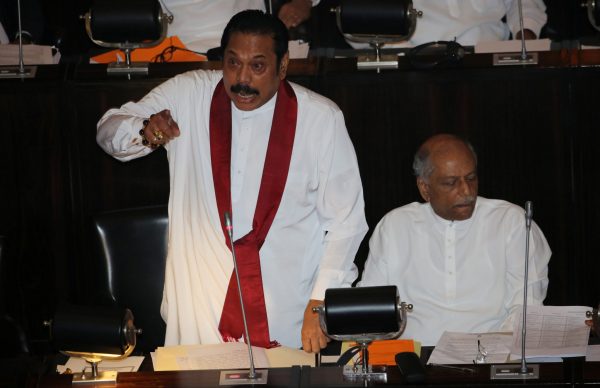On 26 October 2018, President Maithripala Sirisena dismissed Wickremesinghe and inducted Rajapaksa as the new prime minister. Sirisena then suspended parliament until 16 November 2018 to prevent Wickremesinghe from proving his majority in the parliament.
Wickremesinghe insists that he is still the prime minister, refusing to vacate the prime minister’s official residence at Temple Trees. He has also requested that the Speaker of Parliament convene an emergency session for him to demonstrate his majority.
Sirisena said the main reason for sacking Wickremesinghe was the alleged involvement of a cabinet minister in an attempt to assassinate him. But this story is simply an excuse. Sirisena has been planning to get rid of Wickremesinghe for months.
Sirisena, from the Sri Lanka Freedom Party (SLFP), initially appointed Wickremesinghe from the United National Party (UNP) as his prime minister as part of an alliance. Tensions between the SLFP and UNP have been simmering for some time due to administrative and economic policy differences. The triumph of Rajapaksa’s Sri Lanka Podujana Peramuna (SLPP) over both parties in recent local elections aggravated these tensions.
Sirisena was general secretary in Rajapaksa’s government before he defected to run in the 2015 presidential elections. With the backing of UNP, Sirisena ran on a platform of anti-corruption, economic reform and transitional justice. Luck was on his side as he won 51.3 per cent of the total vote over Rajapaksa, who received 47.6 per cent. Tamil and Muslim minority communities voted for and saw Sirisena as a beacon of hope, one that would usher in a new brand of politics.
In contrast, Wickremesinghe’s political career has been riven with bad luck. He has been prime minister for four different tenures since 1983. The question now is whether his latest ouster will spell the demise of his political career or whether he will manage to make a comeback in the forthcoming presidential elections.
While Wickremesinghe’s supporters insist that his dismissal is unconstitutional, 20 legislators are reportedly planning to switch sides. Defecting from a party and joining the opposition is common in Sri Lankan politics. Unlike other democracies where politicians have an ideological backing and loyalty to their respective parties, it is not uncommon for government officials in Sri Lanka to change parties for political gain.
Sirisena is well aware that his chances of returning as president are slim given the government’s poor performance in the last three years. An opinion poll conducted by the Centre for Policy Alternatives in April 2017 stated that only 1.1 per cent of the respondents thought that the government’s performance has been excellent and does not require further improvement.
Public approval of the government’s performance plunged due to its inability to tackle corruption, inflation, unemployment and post-war grievances. The country was listed as 91 out of 176 countries in Transparency International’s 2017 Corruption Perception Index. Corruption is entrenched at every level of the state’s administration. Companies have reported instances of bribes and other forms of unwarranted payment, especially in public procurement processes. The government was also hit by the Central Bank bond scandal where the onus fell on Wickremesinghe.
So Sirisena covertly reached out to Rajapaksa for a political alliance. The President was reportedly cutting deals with Rajapaksa earlier this year. He is now capitalising on Rajapaksa’s strong support from the country’s Sinhalese community mainly in the southern, western and central provinces. Their loyalty to the former president has increased with the Sirisena government’s poor delivery.
Rajapaksa’s comeback as prime minister shows that he was a key player in the country’s political landscape all along, even when he sat as an opposition legislator. But amid the ongoing political uncertainty in Sri Lanka, with the Supreme Court overturning Sirisena’s decision to dissolve parliament and call for early elections, there is a high likelihood that Rajapaksa will not be recognised as the new prime minister. Perhaps Sirisena’s good luck is withering away.
Roshni Kapur is a Research Assistant at the Institute of South Asian Studies, an autonomous research institute at the National University of Singapore (NUS).
A version of this article was originally published here on RSIS.

